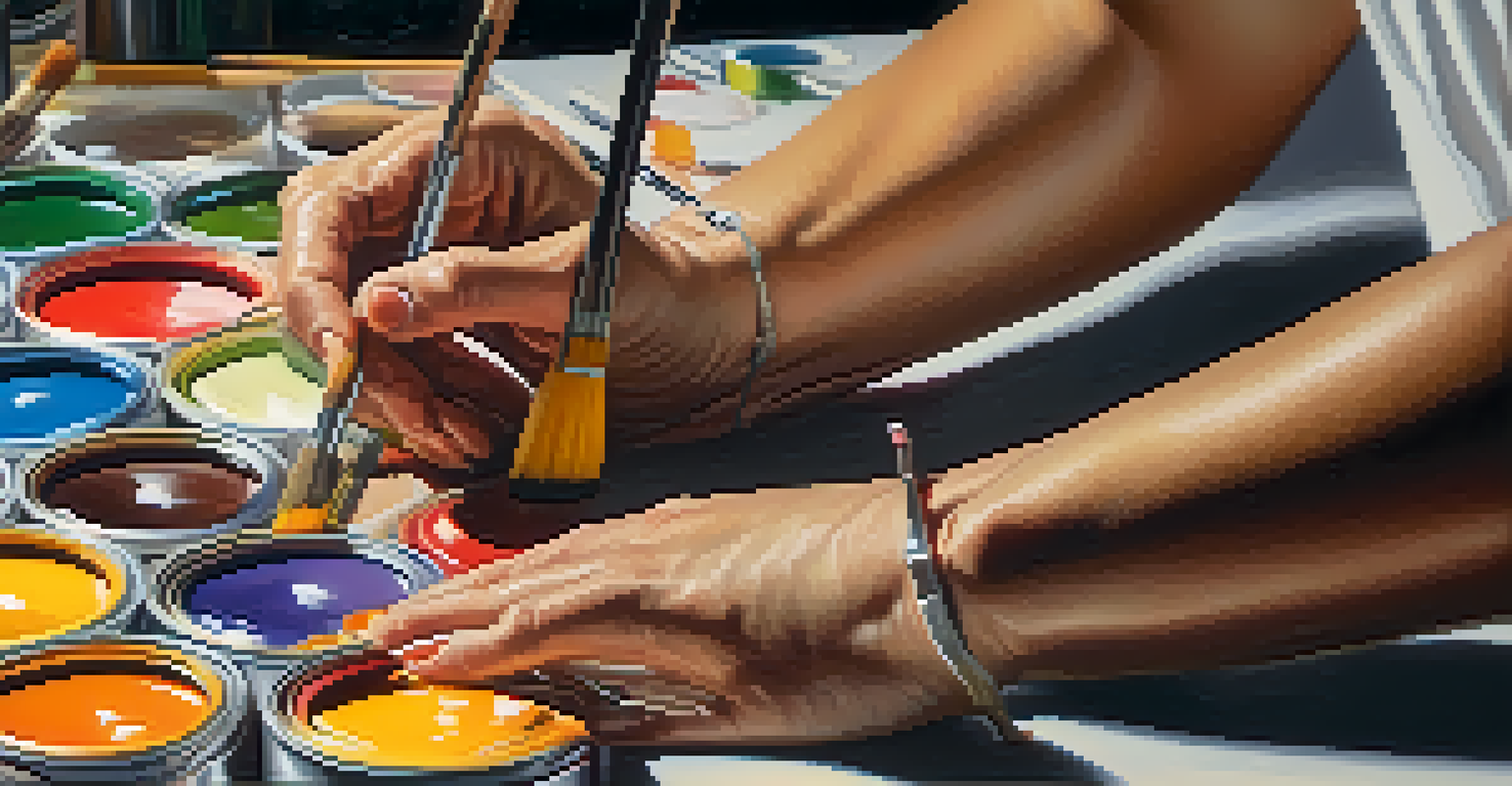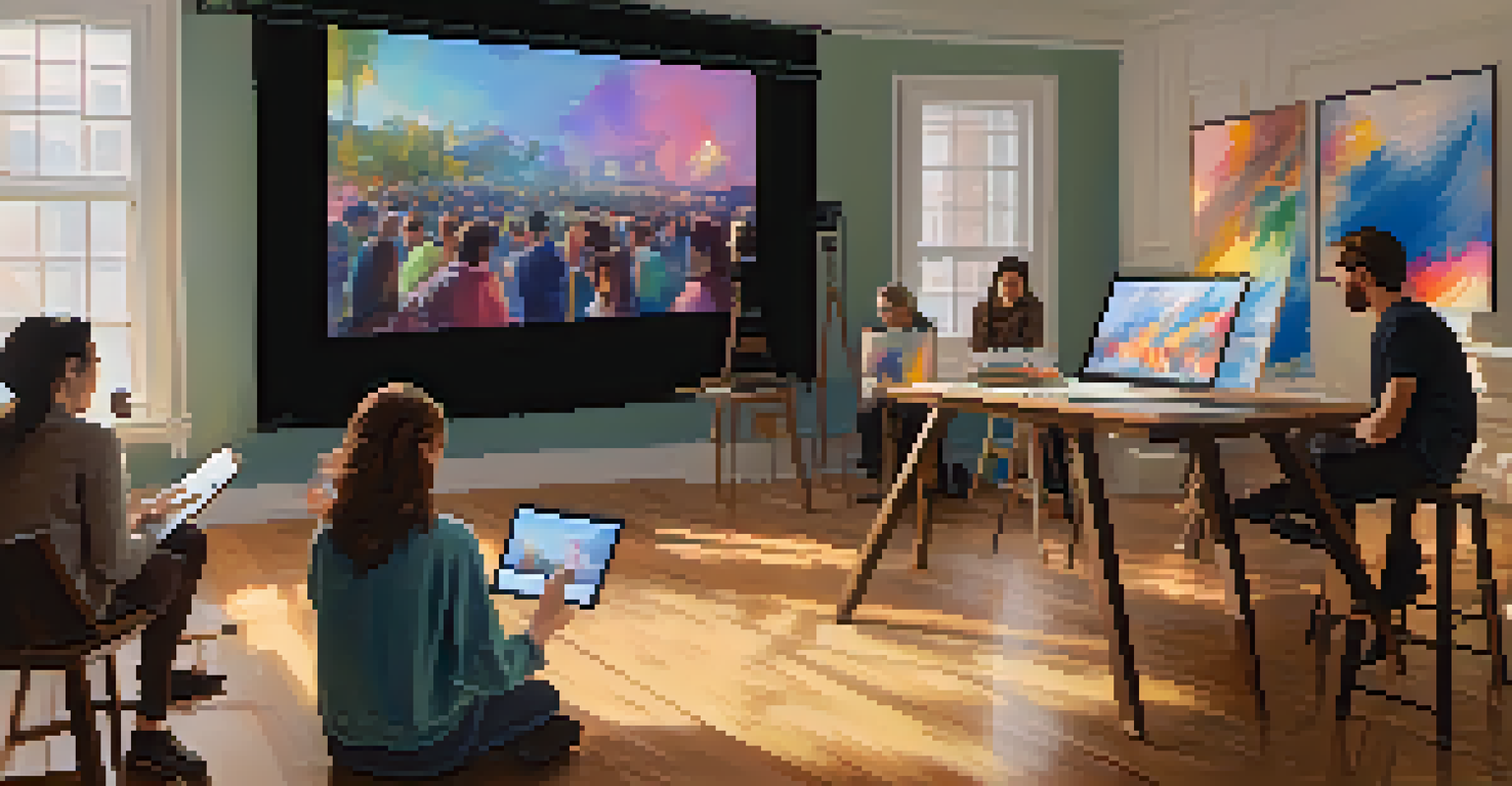Live Streaming Art: Engaging Audiences in Real-Time Creation

Understanding Live Streaming Art and Its Appeal
Live streaming art is an innovative way for artists to showcase their creative process in real-time. It allows audiences to witness the magic of creation as it unfolds, breaking down the traditional barriers between the artist and the viewer. This immediacy not only enhances the viewer's experience but also fosters a sense of connection and community.
Art is not freedom from discipline, but disciplined freedom.
Imagine watching a painter bring a canvas to life, each brushstroke unfolding before your eyes. This transparency invites viewers into the artist's world, allowing them to appreciate the effort and skill involved in the artistic process. It’s a bit like being a fly on the wall in a creative studio, where every decision is made live, adding layers of excitement and engagement.
Moreover, live streaming art creates a unique platform for interaction. Viewers can comment, ask questions, and even suggest ideas in real-time, making them feel like an integral part of the creation. This engagement can turn a solitary act of creation into a vibrant, communal event that resonates with both the artist and the audience.
The Technology Behind Live Streaming Art
At its core, live streaming art relies on technology to connect artists and audiences across distances. With just a camera and an internet connection, artists can broadcast their creative sessions to anyone, anywhere in the world. This accessibility has democratized art, allowing more people to engage with artists they admire.

Platforms like Twitch, YouTube, and Instagram have become popular venues for live streaming art. They provide tools that allow artists to reach a wide audience while also offering features that enable audience interaction. This means that not only can viewers watch the art being created, but they can also influence it, making the experience more dynamic.
Live Streaming Fosters Connection
Live streaming art breaks down barriers, allowing real-time interaction between artists and audiences, fostering a sense of community.
However, it’s important for artists to choose the right platform that aligns with their audience and style. Each platform has its unique features and audience demographics, so understanding where to stream can make a significant difference in engagement levels. This strategic choice ensures that artists can maximize their reach and impact.
Building a Community Through Live Streaming
One of the most significant benefits of live streaming art is the ability to build a community. Artists can cultivate a loyal following by regularly engaging with their audience and creating a space where viewers feel valued. This sense of belonging enhances the viewer's experience, making them more likely to return for future streams.
Creativity takes courage.
Think of it as hosting a virtual art studio where everyone is welcome to contribute their thoughts and feelings. As the artist engages with the audience, they create a shared narrative that deepens the connection. This interaction transforms passive viewers into active participants, fostering a sense of camaraderie among art lovers.
As artists share their work and personal stories, they humanize their creative process, allowing audiences to relate on a personal level. This storytelling aspect of live streaming can create lasting bonds, turning casual viewers into devoted fans who feel a personal investment in the artist's journey.
Real-Time Feedback: A Double-Edged Sword
While live streaming allows for immediate audience feedback, it can also introduce pressure for artists. The prospect of receiving instant reactions can be daunting, especially for those who thrive in more solitary, reflective environments. Artists must navigate this dynamic to maintain authenticity in their work.
The real-time feedback can be incredibly valuable, providing insights and encouragement that might not be available in traditional settings. It can boost an artist's confidence and motivate them to push boundaries. However, artists should also be mindful of how they handle criticism, as it's important to stay true to their vision despite external opinions.
Monetization Strategies for Artists
Artists can explore various monetization options through live streaming, including viewer donations and selling merchandise, to support their craft.
For many, finding a balance between audience engagement and personal expression is key. Setting boundaries around feedback—like choosing specific times to interact—can help artists maintain their creative flow while still valuing their audience's input. This balance can lead to a more fulfilling experience for both the artist and their viewers.
Monetizing Live Streaming Art: Opportunities and Strategies
As live streaming art gains popularity, artists are exploring various ways to monetize their creative sessions. Options range from viewer donations and subscription models to selling artwork directly during streams. This shift not only supports artists financially but also validates their craft in a digital landscape.
Many platforms offer built-in monetization features, allowing artists to receive tips or sell merchandise directly to their audience. For instance, platforms like Patreon enable artists to create exclusive content for subscribers, fostering a deeper connection with their most dedicated fans. This can lead to a sustainable income stream that complements their artistic endeavors.
However, successful monetization requires artists to be strategic about their offerings. It’s essential to communicate the value of their work and engage their audience in a way that feels authentic. By combining creativity with business savvy, artists can build a thriving ecosystem that supports their passion for art.
The Role of Social Media in Promoting Live Art Streams
Social media plays a crucial role in promoting live streaming art, acting as a bridge between artists and potential viewers. Platforms like Instagram and Twitter allow artists to share snippets of their work, tease upcoming streams, and engage with their audience in a more personal way. This pre-stream engagement can significantly boost viewer turnout.
Think of social media as the stage where artists can showcase their personality and artistic style before the main event. By sharing behind-the-scenes content, artists can build anticipation and excitement, drawing in a larger audience for their live sessions. This strategy not only enhances visibility but also deepens the connection with followers.
Social Media Boosts Audience Engagement
Social media serves as a vital tool for artists to promote their live streams and connect with viewers, enhancing visibility and anticipation.
Additionally, collaborating with other artists or influencers on social media can amplify reach and introduce new audiences to an artist's work. These collaborations create a ripple effect, expanding the artist's network and fostering a sense of community among creators. It’s a win-win situation that benefits everyone involved.
The Future of Live Streaming Art: Trends and Predictions
As technology continues to evolve, the landscape of live streaming art is set to expand even further. We can expect to see advancements in virtual and augmented reality that will offer immersive experiences for viewers. This evolution will not only enhance engagement but also create new avenues for artistic expression.
Emerging trends like interactive art experiences and gamification are likely to gain traction. Imagine being able to step into a virtual gallery where you can influence the artwork being created in real time. Such innovations will push the boundaries of traditional art forms, inviting audiences to participate in ways we can't yet fully envision.

Ultimately, the future of live streaming art holds endless possibilities for artists and audiences alike. As these trends unfold, they will shape how we perceive and interact with art, making it more accessible and engaging than ever before. The journey of live streaming art is just beginning, and it promises to be an exciting ride for all involved.